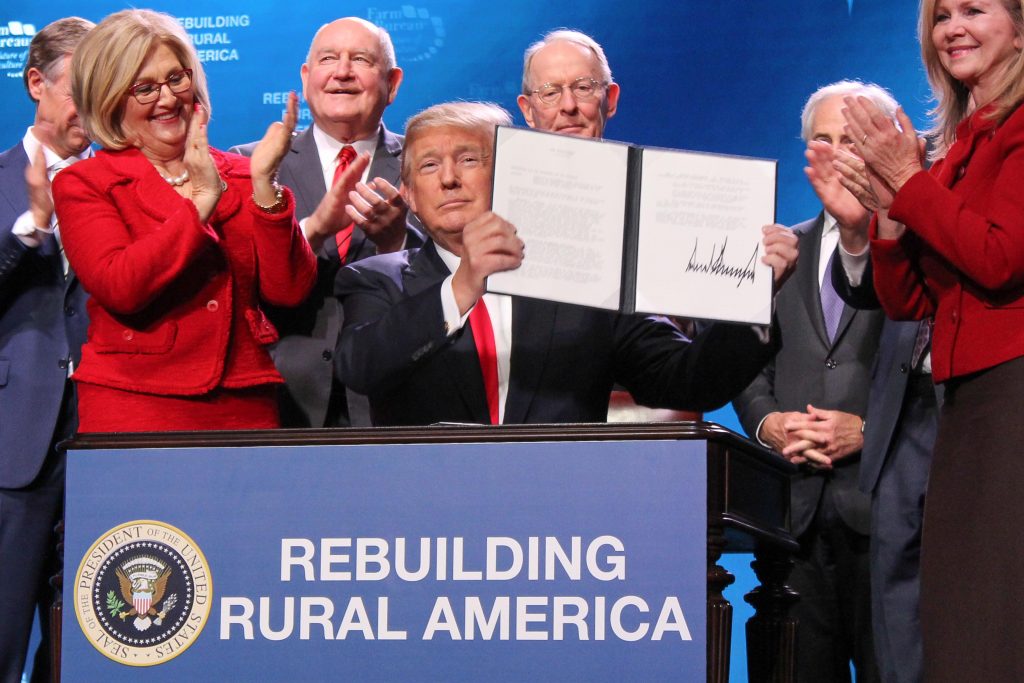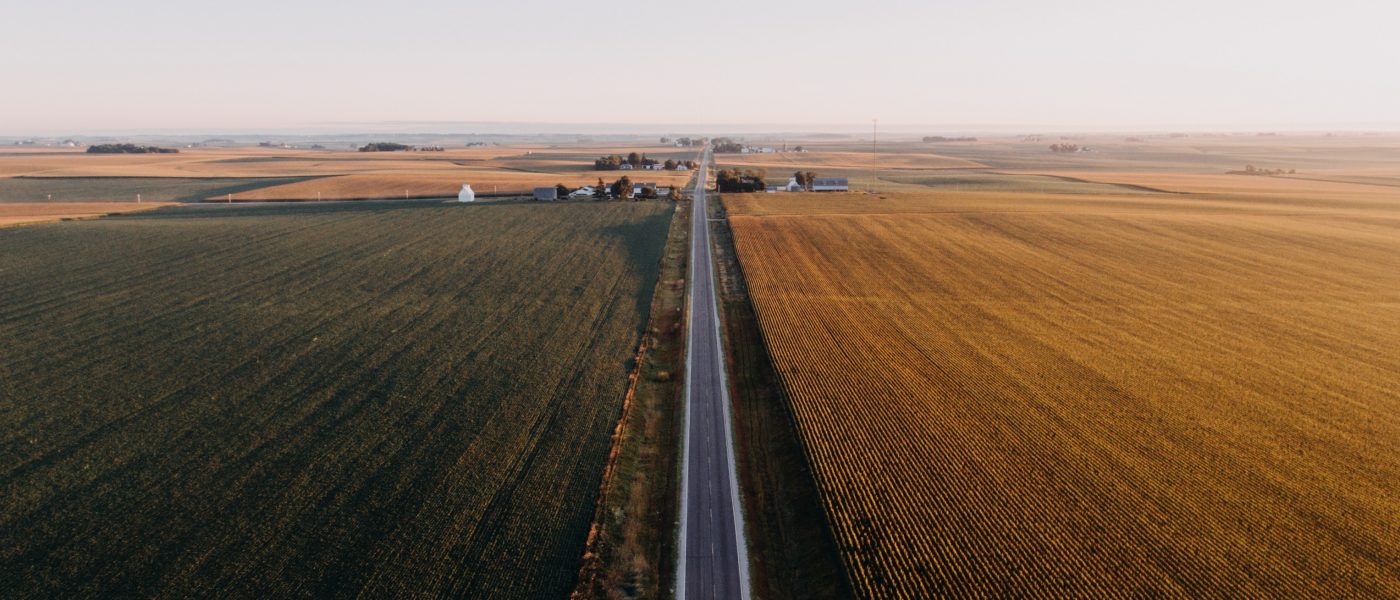The last time a new president entered office, Farm Aid conducted a “State of the Family Farm,” assessing then-President Obama’s policy impact on farmers and agriculture in his first year in office. The first anniversary of President Trump’s inauguration gives us the chance to do it again. There’s a lot to cover, and we’re going to start with some of the topics Trump raised at the annual meeting of the American Farm Bureau Federation on January 8.
Trump’s presence at the Farm Bureau meeting was championed by farmers, many of whom said it was the first time in a long time a sitting president addressed them directly. That is important — farmers deserve to be heard and to have their concerns addressed. Many farmers, however, were disappointed that President Trump failed to address the major challenges that farmers are up against. Farmers have now seen four years of slumping farm prices, and net farm income is currently 50 percent of what it was in 2013. In our opinion, that should have been the first thing President Trump mentioned.
Tax Cuts
President Trump touted the money farm families would save from the recently passed tax reform bill. He claimed that $5.5 trillion in tax cuts would go “to working families, small businesses, and … the family farmer.” But the statement was immediately rebutted by fact checkers, because the estimated value of the tax cuts over the next 10 years is actually $1.5 trillion for families and businesses — not $5.5 trillion. In addition, data from the USDA’s Economic Research Service estimates that up to 80 percent of the law’s benefits for farmers will go to the top 1 percent of farm households by income, while the bottom 20 percent of farm households will actually see a tax increase under the law.
Even for farmers who are able to access the tax law’s benefits, as Mark Watne, president of the North Dakota Farmers Union put it: “Tax cuts only help when you actually have income that puts in you in a tax paying scenario. Currently, it is hard to project profit with low commodity prices. Farm program support is much more important at this time to ensure farms can continue to operate.”
To that point, an unintended consequence of the new tax law could be the loss of important farm programs through the USDA. According to the Center for Rural Affairs, under existing budget sequestration rules (put in place to control the federal deficit), countless federal programs could see automatic budget cuts as soon as 2018. For example, $3.8 billion would be cut from Farm Bill programs including those that support conservation, beginning farmer, and small town infrastructure programs, all of which are instrumental in strengthening family farms and rural communities.
Estate Tax
President Trump touted the changes to the estate tax as having a positive effect on all farmers, which has long been a talking point of those who wish to abolish the estate tax. Here’s the reality: Under the previous law, a married couple could pass on $11 million of assets in their estate without paying any estate tax. What does that mean in practicality? As Wisconsin farmer Jim Goodman put it in an op-ed;
“Only about 20 farms a year are subject to any inheritance tax, and in almost all cases, those farms have adequate liquid assets to cover the taxes without having to sell any part of the business to do so … After searching for 35 years for one example of a family farm that was lost due to the estate tax, Iowa State professor Neil Harl stated simply, ‘It’s a myth.’”
The final tax reform bill that was passed will double the estate tax exemption to $22 million per couple. Bottom line: The change in the estate tax is not going to impact the average family farm. It is a cut for the wealthiest individuals, and allows for a continued consolidation of wealth, which drives independent family farmers off the land.
Deregulation
President Trump said his Administration was putting an end to the “regulatory assault” and “relentless intrusion from an army of regulators.” So far, the deregulation relating to agriculture has involved killing protections that many family farmers fought for.
Waters of the U.S. Rule
Take for instance, the Waters of the U.S. (WOTUS) rule, which Trump withdrew in June by executive order. The intention of WOTUS was to clarify the regulatory boundaries and jurisdiction for water protections. A major public relations effort on behalf of Big Ag created a hugely successful misinformation campaign that made farmers fear every puddle on their farm would be regulated (when in reality farms were exempt from the new rules, as laid out on page 8 of the 299 page introduction to the rule: “This rule not only maintains current statutory exemptions, it expands regulatory exclusions from the definition of “waters of the United States” to make it clear that this rule does not add any additional permitting requirements on agriculture.”). With its withdrawal, clarity around water protections is once again missing.

U.S. Secretary of Agriculture Sonny Perdue ceremonially presents the findings of the Interagency Task Force on Agriculture and Rural Prosperity to President Donald J. Trump at the 2018 American Farm Bureau Annual Convention in Nashville, Tennessee, January 8, 2018. USDA Photo
Farmer Fair Practices Rules
Another deregulatory action that has a large impact on farmers is the October 2017 withdrawal of the Farmer Fair Practices Rules, which sought to level the playing field for contract farmers who raise poultry for Tyson, Perdue and other large corporations. These rules were intended to ensure farmers and ranchers the most basic of protections in response to decades of documented abuse. One of these protections would have allowed producers redress for anticompetitive behavior by companies without meeting the nearly impossible standard of proving that a company’s actions hurt the entire livestock industry, not just the individual farmer. Another of the rules would have blocked companies from requiring that farmers make expensive and unnecessary upgrades to their operations, which often has the effect of keeping farmers mired in debt.
Like the next rule we’ll discuss, the Farmer Fair Practices Rules were in the works for years, with broad support from family farmers. With this decision, the Trump Administration is standing on the side of multinational meatpackers, not America’s farmers and ranchers. The outpouring of support for the move coming from industry outfits like the National Chicken Council and the National Pork Producers Council is striking when compared to the deep hurt from farmers and ranchers, such as the following from poultry grower Mike Weaver:
“This withdrawal is a slap in the face to rural America and America’s farmers and ranchers. The administration is allowing corporations to hold America’s farmers and ranchers hostage with their monopolistic, retaliatory and predatory practices.”
Organic Livestock and Poultry Practices Rules
Now the Administration is attempting to stop implementation of the Organic Livestock and Poultry Practices Rules, which after 14 years of policy work and input from farmers, eaters and the food industry would have tightened animal welfare standards for organic livestock production (meat, eggs and dairy). The rules would have established a consistent standard by resolving ambiguity about outdoor access for poultry, and creating clear requirements for the raising, transporting and slaughtering of organic animals. Organic farmers and advocates have called out the USDA for pandering to corporate interests to kill this rule. The impact will be to damage the integrity of the organic label and market, which represents a tremendous opportunity for family farmers and sustainable agriculture.
Federal regulatory overreach can make an attractive bogeyman, but good regulations could create a more level playing field for family farmers, reward them for production practices that are positive for the water and for livestock, and help them distinguish their high-quality products in the marketplace. But it’s clear that the interests of family farmers are not the same as the interests of corporate agribusiness.
Update: On March 12, 2018, the USDA officially withdrew implementation of these rules.
Rural Broadband
Millions of Americans, including over a third of rural citizens according to 2016 reports, still can’t access highspeed internet. President Trump signed two presidential orders at the end of his Farm Bureau speech, both aimed at increasing rural broadband access. The proposals to expedite the federal permit process and make more federal lands accessible don’t offer any new funding to actually deploy broadband in rural areas. But President Trump did say, “We’re going to be spending the necessary funds and we are going to get you taken care of. It’s about time.”
It is about time, and Congress has begun with a number of bills, but the federal funding has got to be there. According to Pennsylvania Rep. Mike Doyle of the House Communications and Technology Subcommittee, “It would require tens of billions of dollars to bring broadband to unserved and underserved parts of the country. The private sector hasn’t done it because they know they wouldn’t make a profit on it.” In order words, without federal funding, the situation for rural residents without reliable internet service does not change. After President Trump spoke at the Farm Bureau Meeting, Federal Communications Commission (FCC) chairman Ajit Pai proposed a modest $500 million in spending to close the broadband gap. Experts on expanding rural broadband access say it will take a lot more money to start having a real impact, but see they this as a solid first step. We’ll continue watch this one closely.
Summary
For most family farmers, the impact of tax cuts and deregulation is far less significant than a robust Farm Bill that:
- continues investment in beginning farmers, local and regional food systems, organic agriculture and rural development;
- addresses the challenges that farmers are facing now, from historically low prices to anticompetitive practices in the marketplace;
- focuses not just on the largest producers, but the full range of scale in agriculture;
- ensures equitable access to good food for all and equitable access to the credit, crop insurance and technical assistance farmers rely on; and
- rewards farmers for conservation practices that steward our precious natural resources of soil and water.
Read more in our follow-up post, One Year In: The Trump Administration on Trade & The Farm Bill.



